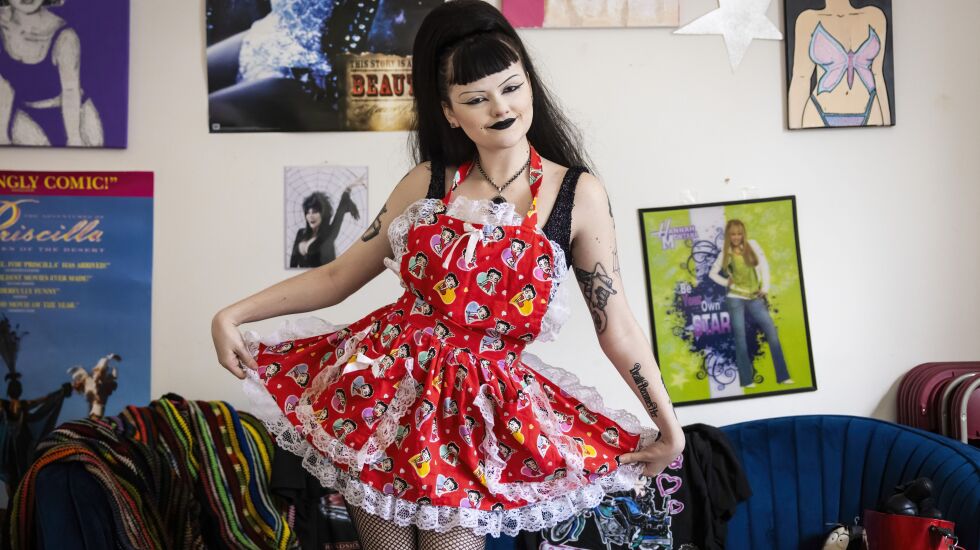
One was the creator of a squeaky-clean mouse named Mickey, the other the brains behind a squeaky-voiced flirt with the catchphrase “Boop-oop-a-doop.”
But the two great American animators — Walt Disney and Max Fleischer — didn’t meet for the first time until 1956, more than a quarter of a century after the introduction of each of their hugely famous creations.
Fleischer stood 5-feet-5-inches tall and had a paunch. Disney was almost 6-feet, slender and had a full head of dark, slicked-back hair.
“Walt was a charming, flattering host,” Fleischer’s son Richard Fleischer wrote in “Out of the Inkwell,” a 2005 biography of his father. “My father seemed to be enjoying himself, but in Walt’s presence, he seemed diminished, and my heart broke for him. I had the feeling that Goliath had defeated David.”
Defeated? Click on eBay, and you’ll find 140,000-plus Betty Boop-themed items for sale — everything from a $600 silver spoon to figurines, T-shirts and even a “hooded tank shirt 4 unisex bearded dragons” listed for $24.99. There are countless Boop-related Facebook pages, including one that boasts it has 1.4 million followers.

And now comes “Boop! The Musical,” which is in its world-premiere, pre-Broadway run at Chicago’s CIBC Theatre, 18 W. Monroe St.
In case you’re wondering, Boop’s signature spit curls are not framing a giant prosthetic head.
Jasmine Amy Rogers — whose credits include playing Gretchen Wieners in the national touring production of “Mean Girls,” Melody Green in “The Wanderer” at Paper Mill Playhouse and a TV appearance on the Paramount+ series “Evil” — stars as the pop culture icon.
What accounts for the tiny-waisted, sexually provocative cartoon character’s enduring appeal 90-some years after she first sashayed across American movie screens?
Ask Maison Monroe, a 21-year-old Columbia College student whose Goth look is part-Elvira, part-Boop.
“She is this very cool character,” says Monroe, who grew up watching Boop cartoons on her grandmother’s VHS player. “In the 1930s, she was this sexually promiscuous character. Women were not really seen like that. It was kind of badass and rebel of her.”
Bob Martin, the musical’s writer, says part of what intrigued him about Betty Boop is that most people living today haven’t seen the crackly cartoon shorts. They know Boop perhaps only as an image on a T-shirt or keychain.

Mark Fleischer, the animator’s grandson, calls that the “miracle of Betty Boop.”
Interest in Boop merchandise took off in the 1970s, a time you could only watch the cartoons as reruns on TV. That interest has grown “vastly, exponentially,” he says.
So have her many incarnations. Boop has appeared as a cowboy, a zombie, part of the zodiac.
She was ahead of her time, and she’s hard to pigeonhole. She was portrayed as lion tamer, a pilot and a successful presidential candidate, says Mark Fleischer, chairman of the board and chief executive officer of Fleischer Studios Inc., which licenses Boop and other Max Fleischer creations.
“We’ve seen a lot of people who ask to have her image put with their loved ones in their final resting places,” he says.
“Part of what really interested me is that Betty herself has become a kind of representative for strong, sexy, smart women,” Martin says. “In our story, she comes from her cartoon world into the real world and is very surprised to learn that she is an icon and that people have applied meaning to who she is. It kind of freaks her out a bit.”

Max Fleischer, the son of Polish Jews settling in New York at the turn of the 20th century, loved to draw from a young age. His artwork had a grittier, more urban feel than Disney’s — probably because he lived in Brooklyn and then Manhattan.
He had an inventor’s mind, developing a machine he called the “Rotoscope,” which allowed him to hand-trace, frame by frame, motion-picture footage to be used in animation — making it less crude and stuttery than was common when Fleischer was getting started.
Betty Boop started out as a half-dog, half-female creation, appearing for the first time in the 1930 short “Dizzy Dishes.”
She soon morphed into the flirty girl next door, debuting with the name Betty Boop in 1931’s “Minding the Baby.” She was an instant hit for Paramount Pictures, according to Richard Fleischer, who died in 2006.
“Several squeaky female voices were tried out in the early Betty Boops, but none seemed exactly right,” he wrote in his book. “The voice needed to be squeaky, but it also needed to be cute and sexy, to sing, to do good line readings and to be able to say and sing ‘Boop-oop-a-doop’ in exactly the right way.”
Max Fleischer settled on the American actress Mae Questel, who was Boop’s voice for all 118 animated shorts.

But just who provided the inspiration for the voice is up for debate.
Helen Kane, a popular singer in the 1930s, said Max Fleischer stole her singing style to create Boop, and she sued for $250,000 in a case that made front-page news in New York. A judge ruled against Kane after it came to light that the Black, Chicago-born singer and dancer Esther Lee Jones was singing in that style long before Kane.
Betty Boop “was born of that age,” according to Mark Fleischer. “She embodies the collective creativity and energy and the many artists” of the day.
In the beginning, Boop’s skirt was so short you could see her garter. A few years later, her hemline dropped drastically in response to self-imposed movie industry guidelines.
“Betty had to change her style,” says Peter Benjaminson, author of the recently released “The Life and Times of Betty Boop: The 100-Year History of an Animated Icon.” “She became a housewife — pretty, but she had a few more pounds. She had a dog. She cleaned the house.”
Even with the makeover, Boop never lost that odd blend of infant and fully developed woman.

Grace Kessler Overbeke, an assistant theater professor at Columbia College Chicago, says that explains part of Boop’s appeal.
“Setting aside the more sinister implications of sexualizing women through infantilization, women may see a seductive quality in the fantasy of being able to reconcile your adult body with your childhood,” Overbeke says. “The idea that you can be both a girl and a woman at once? That is fantastic.”
The old Boop cartoons were seven or eight minutes long. Will today’s audiences sit in a theater for two-plus hours to see the musical?
Ivan Brunetti — who teaches courses on illustration, cartooning and graphic novels at Columbia — doesn’t see why not. After all, Boop cartoons were essentially 10-minute-long musicals, he says.
“They made a two-hour Barbie movie,” Brunetti says. “So, if you can spin it out of a Barbie doll, you can certainly spin two hours out of Betty Boop.”







